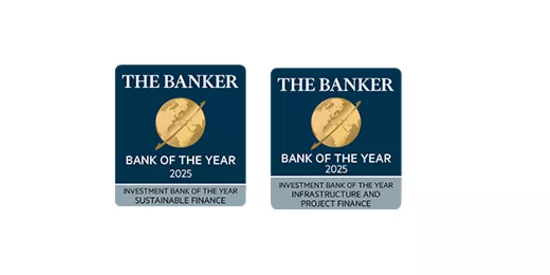
Volatility is back. What does this mean for equity-linked issuance?
The return of stock volatility is creating ideal conditions for issuers of equity-linked bonds.
The recent jump in equity volatility created ripples of fear across many markets. But for potential issuers of equity-linked bonds the volatility spike signals a return to near-perfect market conditions. Equity volatility rose suddenly in February after a prolonged slump, as a downturn in global stock markets shook investors from complacency.
The VIX index of S&P volatility and the comparable VSTOXX index of European blue-chip volatility fell from their February close of day highs of 37 and 35 respectively. They held at levels well above their 2017 lows during the early weeks of the second quarter of 2018, however. Heightened concern about volatility poses challenges in some equity capital markets. And it has an effect on traditional corporate debt market issuance.
The rise in volatility is driving increased demand for convertible bonds among investors and also broadening the range of structures that are feasible. That means borrowers have a growing menu of equity-linked debt options to consider, with investor appetite for both large and mid-cap deals and in a variety of sectors.
Head of equity-linked issuance at Societe Generale CIB
But the rise in volatility creates opportunities across a range of equity-linked debt structures, according to Societe Generale, which underwrote the greatest number of convertible bonds in Europe in the first quarter of 20181. “The rise in volatility is driving increased demand for convertible bonds among investors and also broadening the range of structures that are feasible,” said Thomas Feuerstein, head of equity-linked issuance at Societe Generale CIB. “That means borrowers have a growing menu of equity-linked debt options to consider, with investor appetite for both large and mid-cap deals and in a variety of sectors.”
Convertible bond issuance in both the US and Asia was busier than in Europe during the first quarter, which creates scope for European issuers to match unmet demand with new deals. Strong credit fundamentals for European corporations also set the scene for an increase in equity-linked debt issuance in the region, with projected default rates for the end of 2018 at much lower levels than in the US2.
The appeal for potential issuers of equity-linked debt is clear. Borrowers can effectively monetize the recent rise in stock volatility while achieving a low cost of debt, just as concern is mounting about the effect on corporate bond costs of steps to unwind easing policies by the European Central Bank. Even small cap issuers can target a zero-cost coupon structure by selling equity-linked debt, and large well-rated issuers can potentially achieve negative rates on deals.
1 Source: IFR League Table Global Convertible Offerings – EMEA, 1/1/2018–31/3/2018
2 Source: Moody’s – 09 February 2018, projected end 2018 default rate at 2.2% in US and 1% in Europe

The equity-linked debt markets have also seen a number of structural innovations in recent years, such as the revival of the non-dilutive convertible bond. The recent rise in volatility further extends the equity-linked options available to borrowers.
But even an improved market backdrop cannot function as a substitute for advisory experience, structuring expertise and a distribution network that ensures full placement of new bonds. Some recent transactions were too aggressively priced, resulting in limited demand from investors and underlining the need for careful deal structuring. Timing and pricing of new deals are as important for the equity-linked debt markets as they are for other sectors, and arguably more so – given that many investors are specialist fund managers who expect an input on structuring terms.
The extent to which specialist convertible bond investors underpin the equity-linked debt markets is also a source of strength for the sector, however. The dominance of these investors means that equity-linked bonds are not as exposed to flows from passive investors, such as exchange-traded funds (ETFs). This is different from many other sectors, including the mainstream corporate bond market, where the growing importance of ETF flows can exacerbate price movement, including in periods such as the first quarter of 2018, when benchmark indices had net losses.
Equity-linked debt was one of the relatively few asset classes to see a gain during the first quarter, by contrast. Total returns for convertible bonds and other equity-linked debt will be driven by a variety of factors for the rest of the year.
But the return of volatility should ensure that there are opportunities for cost-effective issuance for borrowers who are able to act decisively.
Equity Capital Markets Trends
The return of stock volatility is creating ideal conditions for issuers of equity-linked bonds.
The recent jump in equity volatility created ripples of fear across many markets. But for potential issuers of equity-linked bonds the volatility spike signals a return to near-perfect market conditions. Equity volatility rose suddenly in February after a prolonged slump, as a downturn in global stock markets shook investors from complacency.
The VIX index of S&P volatility and the comparable VSTOXX index of European blue-chip volatility fell from their February close of day highs of 37 and 35 respectively. They held at levels well above their 2017 lows during the early weeks of the second quarter of 2018, however. Heightened concern about volatility poses challenges in some equity capital markets. And it has an effect on traditional corporate debt market issuance.
The rise in volatility is driving increased demand for convertible bonds among investors and also broadening the range of structures that are feasible. That means borrowers have a growing menu of equity-linked debt options to consider, with investor appetite for both large and mid-cap deals and in a variety of sectors.
Head of equity-linked issuance at Societe Generale CIB
But the rise in volatility creates opportunities across a range of equity-linked debt structures, according to Societe Generale, which underwrote the greatest number of convertible bonds in Europe in the first quarter of 20181. “The rise in volatility is driving increased demand for convertible bonds among investors and also broadening the range of structures that are feasible,” said Thomas Feuerstein, head of equity-linked issuance at Societe Generale CIB. “That means borrowers have a growing menu of equity-linked debt options to consider, with investor appetite for both large and mid-cap deals and in a variety of sectors.”
Convertible bond issuance in both the US and Asia was busier than in Europe during the first quarter, which creates scope for European issuers to match unmet demand with new deals. Strong credit fundamentals for European corporations also set the scene for an increase in equity-linked debt issuance in the region, with projected default rates for the end of 2018 at much lower levels than in the US2.
The appeal for potential issuers of equity-linked debt is clear. Borrowers can effectively monetize the recent rise in stock volatility while achieving a low cost of debt, just as concern is mounting about the effect on corporate bond costs of steps to unwind easing policies by the European Central Bank. Even small cap issuers can target a zero-cost coupon structure by selling equity-linked debt, and large well-rated issuers can potentially achieve negative rates on deals.
1 Source: IFR League Table Global Convertible Offerings – EMEA, 1/1/2018–31/3/2018
2 Source: Moody’s – 09 February 2018, projected end 2018 default rate at 2.2% in US and 1% in Europe

The equity-linked debt markets have also seen a number of structural innovations in recent years, such as the revival of the non-dilutive convertible bond. The recent rise in volatility further extends the equity-linked options available to borrowers.
But even an improved market backdrop cannot function as a substitute for advisory experience, structuring expertise and a distribution network that ensures full placement of new bonds. Some recent transactions were too aggressively priced, resulting in limited demand from investors and underlining the need for careful deal structuring. Timing and pricing of new deals are as important for the equity-linked debt markets as they are for other sectors, and arguably more so – given that many investors are specialist fund managers who expect an input on structuring terms.
The extent to which specialist convertible bond investors underpin the equity-linked debt markets is also a source of strength for the sector, however. The dominance of these investors means that equity-linked bonds are not as exposed to flows from passive investors, such as exchange-traded funds (ETFs). This is different from many other sectors, including the mainstream corporate bond market, where the growing importance of ETF flows can exacerbate price movement, including in periods such as the first quarter of 2018, when benchmark indices had net losses.
Equity-linked debt was one of the relatively few asset classes to see a gain during the first quarter, by contrast. Total returns for convertible bonds and other equity-linked debt will be driven by a variety of factors for the rest of the year.
But the return of volatility should ensure that there are opportunities for cost-effective issuance for borrowers who are able to act decisively.

Forget volatility, the IPO market is open for business.

Europe’s equity capital markets are evolving fast, creating new options for growth but also more choices and challenges.

Emerging equity capital markets are seeing unprecedented challenges and opportunities, as sovereign and corporate...




